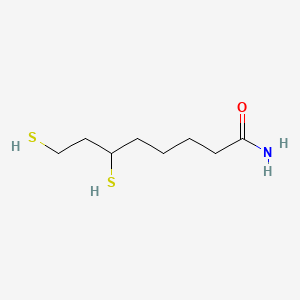| MeSH term | MeSH ID | Detail |
|---|---|---|
| Parkinsonian Disorders | D020734 | 20 associated lipids |
Dihydrolipoamide
Dihydrolipoamide is a lipid of Fatty Acyls (FA) class. Dihydrolipoamide is associated with abnormalities such as Wiskott-Aldrich Syndrome. The involved functions are known as Citric Acid Cycle, Electron Transport, NADH oxidation, Oxidation and Oxidants. Dihydrolipoamide often locates in Mitochondria, Mitochondrial matrix and Chloroplasts. The associated genes with Dihydrolipoamide are Mutant Proteins, Recombinant Proteins, mycothione reductase, Genes, Mitochondrial and alanylproline.
Cross Reference
Introduction
To understand associated biological information of Dihydrolipoamide, we collected biological information of abnormalities, associated pathways, cellular/molecular locations, biological functions, related genes/proteins, lipids and common seen animal/experimental models with organized paragraphs from literatures.
What diseases are associated with Dihydrolipoamide?
Dihydrolipoamide is suspected in and other diseases in descending order of the highest number of associated sentences.
Related references are mostly published in these journals:
| Disease | Cross reference | Weighted score | Related literature |
|---|
Possible diseases from mapped MeSH terms on references
We collected disease MeSH terms mapped to the references associated with Dihydrolipoamide
PubChem Associated disorders and diseases
What pathways are associated with Dihydrolipoamide
There are no associated biomedical information in the current reference collection.
PubChem Biomolecular Interactions and Pathways
Link to PubChem Biomolecular Interactions and PathwaysWhat cellular locations are associated with Dihydrolipoamide?
Visualization in cellular structure
Associated locations are in red color. Not associated locations are in black.
Related references are published most in these journals:
| Location | Cross reference | Weighted score | Related literatures |
|---|
What functions are associated with Dihydrolipoamide?
Related references are published most in these journals:
| Function | Cross reference | Weighted score | Related literatures |
|---|
What lipids are associated with Dihydrolipoamide?
There are no associated biomedical information in the current reference collection.
What genes are associated with Dihydrolipoamide?
Related references are published most in these journals:
| Gene | Cross reference | Weighted score | Related literatures |
|---|
What common seen animal models are associated with Dihydrolipoamide?
There are no associated biomedical information in the current reference collection.
NCBI Entrez Crosslinks
All references with Dihydrolipoamide
Download all related citations| Authors | Title | Published | Journal | PubMed Link |
|---|---|---|---|---|
| Ma M and Liu LZ | Quantitative transcription dynamic analysis reveals candidate genes and key regulators for ethanol tolerance in Saccharomyces cerevisiae. | 2010 | BMC Microbiol. | pmid:20537179 |
| MacGregor P and Matthews KR | New discoveries in the transmission biology of sleeping sickness parasites: applying the basics. | 2010 | J. Mol. Med. | pmid:20526573 |
| Wei LQ et al. | Genome-scale analysis and comparison of gene expression profiles in developing and germinated pollen in Oryza sativa. | 2010 | BMC Genomics | pmid:20507633 |
| Liang L et al. | Large scale immune profiling of infected humans and goats reveals differential recognition of Brucella melitensis antigens. | 2010 | PLoS Negl Trop Dis | pmid:20454614 |
| Lu X et al. | The intra- and extracellular proteome of Aspergillus niger growing on defined medium with xylose or maltose as carbon substrate. | 2010 | Microb. Cell Fact. | pmid:20406453 |
| Park YH and Patel MS | Characterization of interactions of dihydrolipoamide dehydrogenase with its binding protein in the human pyruvate dehydrogenase complex. | 2010 | Biochem. Biophys. Res. Commun. | pmid:20385101 |
| Otero L et al. | Thioredoxin and glutathione systems differ in parasitic and free-living platyhelminths. | 2010 | BMC Genomics | pmid:20385027 |
| Viadas C et al. | Transcriptome analysis of the Brucella abortus BvrR/BvrS two-component regulatory system. | 2010 | PLoS ONE | pmid:20422049 |
| Quintana E et al. | Dihydrolipoamide dehydrogenase (DLD) deficiency in a Spanish patient with myopathic presentation due to a new mutation in the interface domain. | 2010 | J. Inherit. Metab. Dis. | pmid:20652410 |
| Chen W et al. | Disruption of ptLPD1 or ptLPD2, genes that encode isoforms of the plastidial lipoamide dehydrogenase, confers arsenate hypersensitivity in Arabidopsis. | 2010 | Plant Physiol. | pmid:20488895 |
| Pei Y et al. | Plasmodium pyruvate dehydrogenase activity is only essential for the parasite's progression from liver infection to blood infection. | 2010 | Mol. Microbiol. | pmid:20487290 |
| Vijayakrishnan S et al. | Solution structure and characterisation of the human pyruvate dehydrogenase complex core assembly. | 2010 | J. Mol. Biol. | pmid:20361979 |
| Oliver HF et al. | Deep RNA sequencing of L. monocytogenes reveals overlapping and extensive stationary phase and sigma B-dependent transcriptomes, including multiple highly transcribed noncoding RNAs. | 2009 | BMC Genomics | pmid:20042087 |
| Schriek S et al. | Detection of an L-amino acid dehydrogenase activity in Synechocystis sp. PCC 6803. | 2009 | J. Exp. Bot. | pmid:19213808 |
| Bull TJ et al. | A rhodanine agent active against non-replicating intracellular Mycobacterium avium subspecies paratuberculosis. | 2009 | Gut Pathog | pmid:20030828 |
| Yin C et al. | Generation and analysis of expression sequence tags from haustoria of the wheat stripe rust fungus Puccinia striiformis f. sp. Tritici. | 2009 | BMC Genomics | pmid:20028560 |
| Lee HM et al. | Impaired mitochondrial respiration and protein nitration in the rat hippocampus after acute inhalation of combustion smoke. | 2009 | Toxicol. Appl. Pharmacol. | pmid:19133281 |
| Murphy MP | How mitochondria produce reactive oxygen species. | 2009 | Biochem. J. | pmid:19061483 |
| Laia ML et al. | New genes of Xanthomonas citri subsp. citri involved in pathogenesis and adaptation revealed by a transposon-based mutant library. | 2009 | BMC Microbiol. | pmid:19149882 |
| Wang Q et al. | Genome sequence of the versatile fish pathogen Edwardsiella tarda provides insights into its adaptation to broad host ranges and intracellular niches. | 2009 | PLoS ONE | pmid:19865481 |
